Human Resource Development Report for Sun Court Ltd: Analysis
VerifiedAdded on 2020/06/06
|16
|5208
|99
Report
AI Summary
This report provides a comprehensive analysis of Human Resource Development (HRD), focusing on Sun Court Ltd., a property management company. It begins by comparing various learning styles, including Kolb's, VAK, and Honey and Mumford models, and then explores the learning curve and the significance of knowledge transfer in the workplace. The report also examines the role of learning styles and theories in designing effective training events. Furthermore, it delves into the training needs at different organizational levels, evaluates various training methods, and discusses the evaluation of training programs. The report also highlights the government's role in training and development, the influence of the competency movement, and specific training initiatives undertaken by the UK government. Overall, the report offers valuable insights into HRD practices and strategies, providing a detailed overview of the key aspects involved in fostering employee development and organizational success.

Human Resource
Development
Development
Paraphrase This Document
Need a fresh take? Get an instant paraphrase of this document with our AI Paraphraser
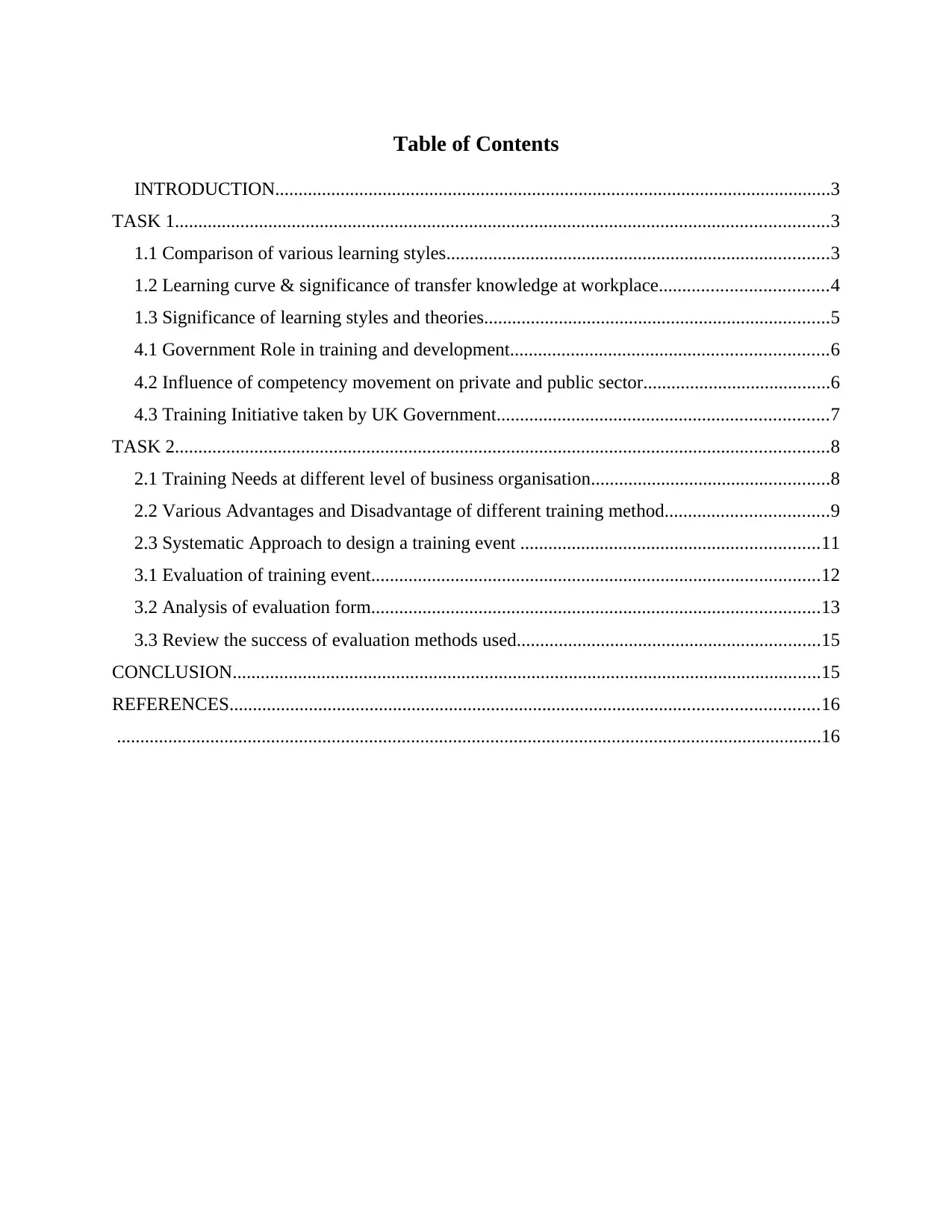
Table of Contents
INTRODUCTION.......................................................................................................................3
TASK 1............................................................................................................................................3
1.1 Comparison of various learning styles..................................................................................3
1.2 Learning curve & significance of transfer knowledge at workplace....................................4
1.3 Significance of learning styles and theories..........................................................................5
4.1 Government Role in training and development....................................................................6
4.2 Influence of competency movement on private and public sector........................................6
4.3 Training Initiative taken by UK Government.......................................................................7
TASK 2............................................................................................................................................8
2.1 Training Needs at different level of business organisation...................................................8
2.2 Various Advantages and Disadvantage of different training method...................................9
2.3 Systematic Approach to design a training event ................................................................11
3.1 Evaluation of training event................................................................................................12
3.2 Analysis of evaluation form................................................................................................13
3.3 Review the success of evaluation methods used.................................................................15
CONCLUSION..............................................................................................................................15
REFERENCES..............................................................................................................................16
.......................................................................................................................................................16
INTRODUCTION.......................................................................................................................3
TASK 1............................................................................................................................................3
1.1 Comparison of various learning styles..................................................................................3
1.2 Learning curve & significance of transfer knowledge at workplace....................................4
1.3 Significance of learning styles and theories..........................................................................5
4.1 Government Role in training and development....................................................................6
4.2 Influence of competency movement on private and public sector........................................6
4.3 Training Initiative taken by UK Government.......................................................................7
TASK 2............................................................................................................................................8
2.1 Training Needs at different level of business organisation...................................................8
2.2 Various Advantages and Disadvantage of different training method...................................9
2.3 Systematic Approach to design a training event ................................................................11
3.1 Evaluation of training event................................................................................................12
3.2 Analysis of evaluation form................................................................................................13
3.3 Review the success of evaluation methods used.................................................................15
CONCLUSION..............................................................................................................................15
REFERENCES..............................................................................................................................16
.......................................................................................................................................................16
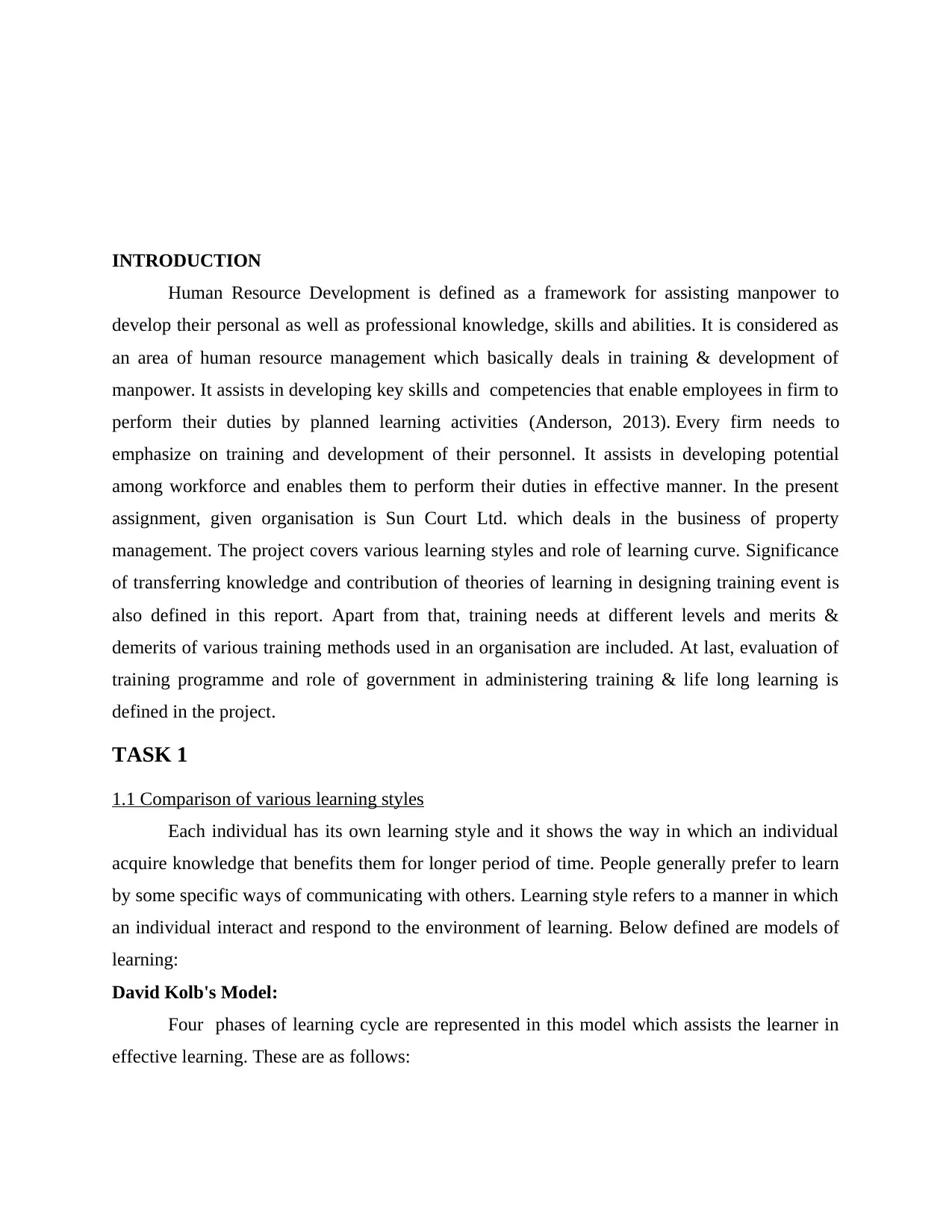
INTRODUCTION
Human Resource Development is defined as a framework for assisting manpower to
develop their personal as well as professional knowledge, skills and abilities. It is considered as
an area of human resource management which basically deals in training & development of
manpower. It assists in developing key skills and competencies that enable employees in firm to
perform their duties by planned learning activities (Anderson, 2013). Every firm needs to
emphasize on training and development of their personnel. It assists in developing potential
among workforce and enables them to perform their duties in effective manner. In the present
assignment, given organisation is Sun Court Ltd. which deals in the business of property
management. The project covers various learning styles and role of learning curve. Significance
of transferring knowledge and contribution of theories of learning in designing training event is
also defined in this report. Apart from that, training needs at different levels and merits &
demerits of various training methods used in an organisation are included. At last, evaluation of
training programme and role of government in administering training & life long learning is
defined in the project.
TASK 1
1.1 Comparison of various learning styles
Each individual has its own learning style and it shows the way in which an individual
acquire knowledge that benefits them for longer period of time. People generally prefer to learn
by some specific ways of communicating with others. Learning style refers to a manner in which
an individual interact and respond to the environment of learning. Below defined are models of
learning:
David Kolb's Model:
Four phases of learning cycle are represented in this model which assists the learner in
effective learning. These are as follows:
Human Resource Development is defined as a framework for assisting manpower to
develop their personal as well as professional knowledge, skills and abilities. It is considered as
an area of human resource management which basically deals in training & development of
manpower. It assists in developing key skills and competencies that enable employees in firm to
perform their duties by planned learning activities (Anderson, 2013). Every firm needs to
emphasize on training and development of their personnel. It assists in developing potential
among workforce and enables them to perform their duties in effective manner. In the present
assignment, given organisation is Sun Court Ltd. which deals in the business of property
management. The project covers various learning styles and role of learning curve. Significance
of transferring knowledge and contribution of theories of learning in designing training event is
also defined in this report. Apart from that, training needs at different levels and merits &
demerits of various training methods used in an organisation are included. At last, evaluation of
training programme and role of government in administering training & life long learning is
defined in the project.
TASK 1
1.1 Comparison of various learning styles
Each individual has its own learning style and it shows the way in which an individual
acquire knowledge that benefits them for longer period of time. People generally prefer to learn
by some specific ways of communicating with others. Learning style refers to a manner in which
an individual interact and respond to the environment of learning. Below defined are models of
learning:
David Kolb's Model:
Four phases of learning cycle are represented in this model which assists the learner in
effective learning. These are as follows:
⊘ This is a preview!⊘
Do you want full access?
Subscribe today to unlock all pages.

Trusted by 1+ million students worldwide
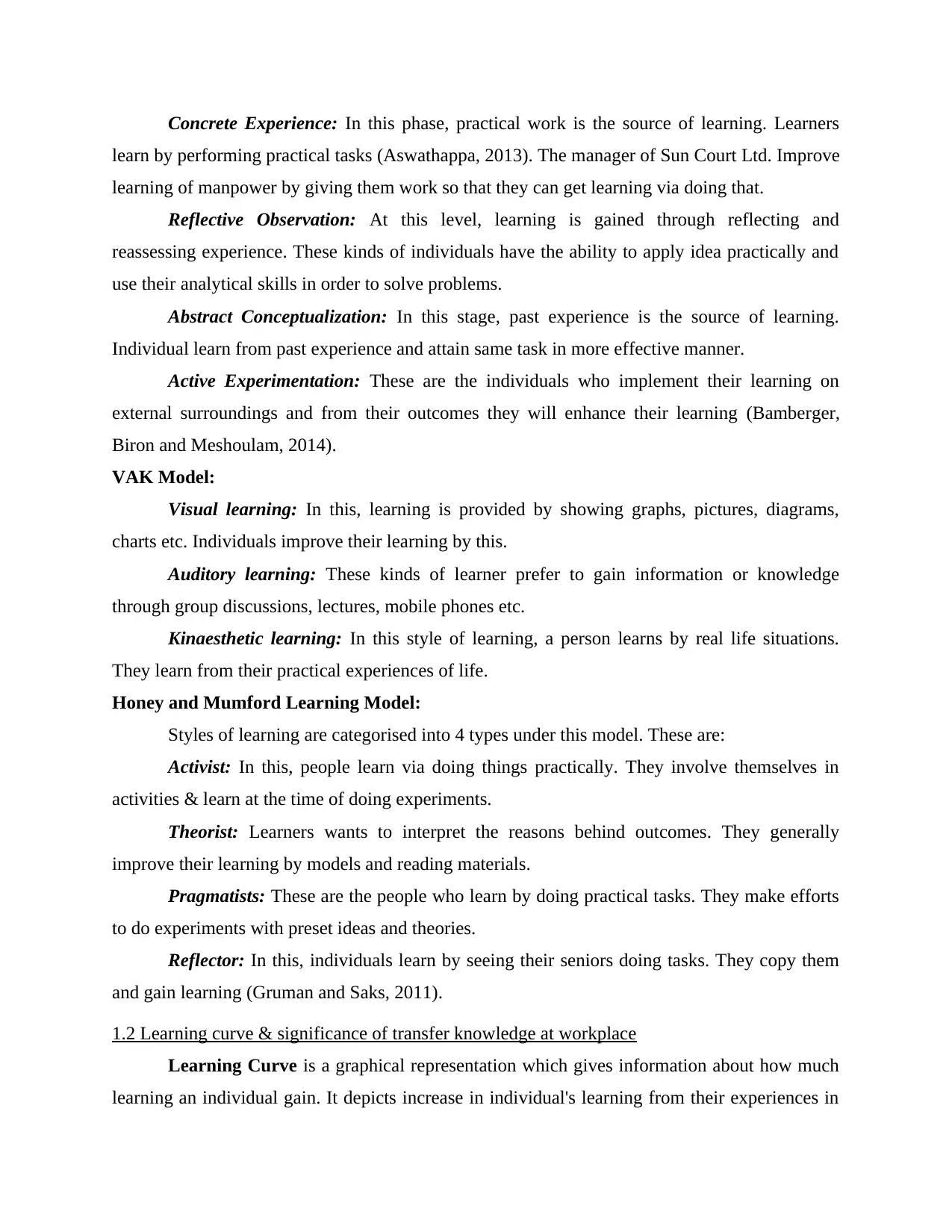
Concrete Experience: In this phase, practical work is the source of learning. Learners
learn by performing practical tasks (Aswathappa, 2013). The manager of Sun Court Ltd. Improve
learning of manpower by giving them work so that they can get learning via doing that.
Reflective Observation: At this level, learning is gained through reflecting and
reassessing experience. These kinds of individuals have the ability to apply idea practically and
use their analytical skills in order to solve problems.
Abstract Conceptualization: In this stage, past experience is the source of learning.
Individual learn from past experience and attain same task in more effective manner.
Active Experimentation: These are the individuals who implement their learning on
external surroundings and from their outcomes they will enhance their learning (Bamberger,
Biron and Meshoulam, 2014).
VAK Model:
Visual learning: In this, learning is provided by showing graphs, pictures, diagrams,
charts etc. Individuals improve their learning by this.
Auditory learning: These kinds of learner prefer to gain information or knowledge
through group discussions, lectures, mobile phones etc.
Kinaesthetic learning: In this style of learning, a person learns by real life situations.
They learn from their practical experiences of life.
Honey and Mumford Learning Model:
Styles of learning are categorised into 4 types under this model. These are:
Activist: In this, people learn via doing things practically. They involve themselves in
activities & learn at the time of doing experiments.
Theorist: Learners wants to interpret the reasons behind outcomes. They generally
improve their learning by models and reading materials.
Pragmatists: These are the people who learn by doing practical tasks. They make efforts
to do experiments with preset ideas and theories.
Reflector: In this, individuals learn by seeing their seniors doing tasks. They copy them
and gain learning (Gruman and Saks, 2011).
1.2 Learning curve & significance of transfer knowledge at workplace
Learning Curve is a graphical representation which gives information about how much
learning an individual gain. It depicts increase in individual's learning from their experiences in
learn by performing practical tasks (Aswathappa, 2013). The manager of Sun Court Ltd. Improve
learning of manpower by giving them work so that they can get learning via doing that.
Reflective Observation: At this level, learning is gained through reflecting and
reassessing experience. These kinds of individuals have the ability to apply idea practically and
use their analytical skills in order to solve problems.
Abstract Conceptualization: In this stage, past experience is the source of learning.
Individual learn from past experience and attain same task in more effective manner.
Active Experimentation: These are the individuals who implement their learning on
external surroundings and from their outcomes they will enhance their learning (Bamberger,
Biron and Meshoulam, 2014).
VAK Model:
Visual learning: In this, learning is provided by showing graphs, pictures, diagrams,
charts etc. Individuals improve their learning by this.
Auditory learning: These kinds of learner prefer to gain information or knowledge
through group discussions, lectures, mobile phones etc.
Kinaesthetic learning: In this style of learning, a person learns by real life situations.
They learn from their practical experiences of life.
Honey and Mumford Learning Model:
Styles of learning are categorised into 4 types under this model. These are:
Activist: In this, people learn via doing things practically. They involve themselves in
activities & learn at the time of doing experiments.
Theorist: Learners wants to interpret the reasons behind outcomes. They generally
improve their learning by models and reading materials.
Pragmatists: These are the people who learn by doing practical tasks. They make efforts
to do experiments with preset ideas and theories.
Reflector: In this, individuals learn by seeing their seniors doing tasks. They copy them
and gain learning (Gruman and Saks, 2011).
1.2 Learning curve & significance of transfer knowledge at workplace
Learning Curve is a graphical representation which gives information about how much
learning an individual gain. It depicts increase in individual's learning from their experiences in
Paraphrase This Document
Need a fresh take? Get an instant paraphrase of this document with our AI Paraphraser
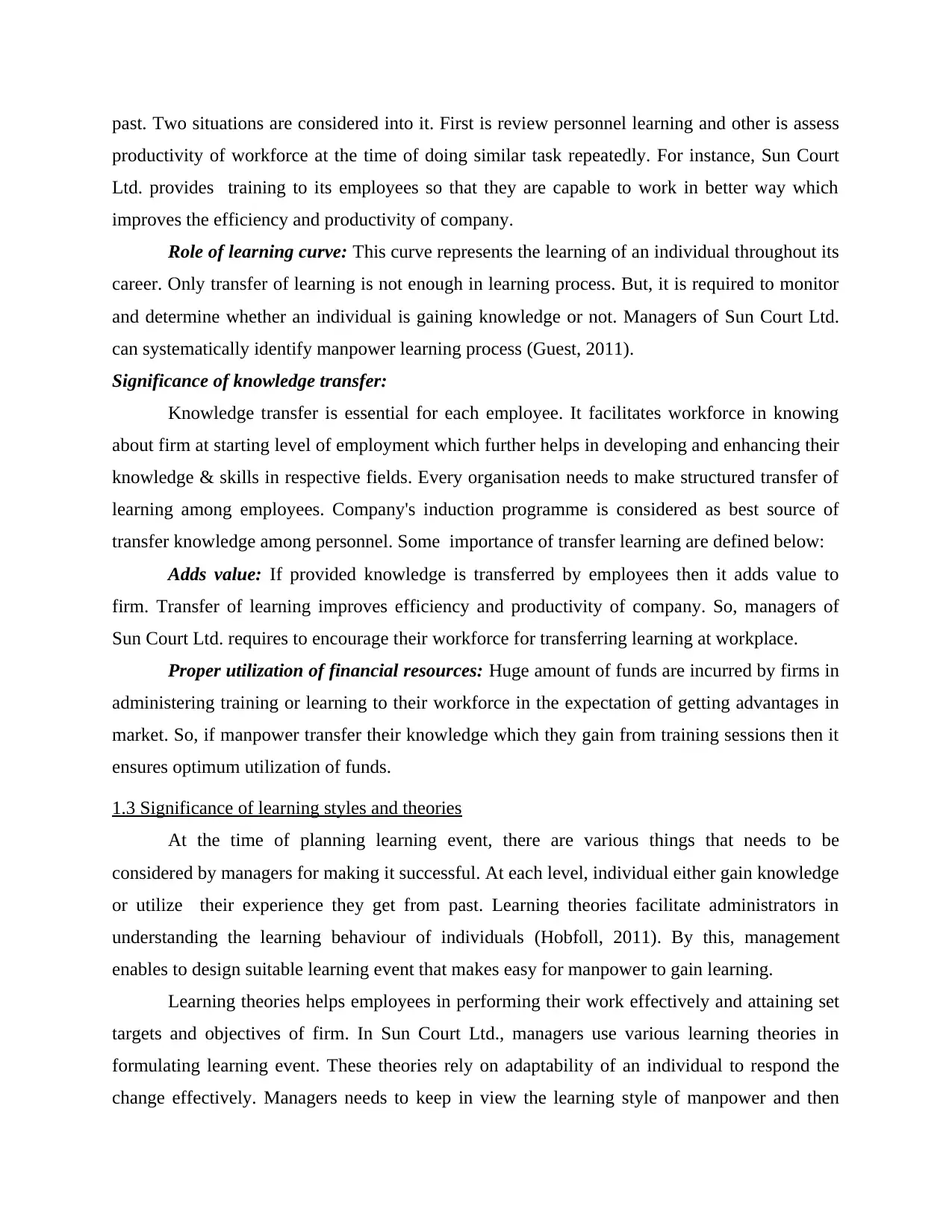
past. Two situations are considered into it. First is review personnel learning and other is assess
productivity of workforce at the time of doing similar task repeatedly. For instance, Sun Court
Ltd. provides training to its employees so that they are capable to work in better way which
improves the efficiency and productivity of company.
Role of learning curve: This curve represents the learning of an individual throughout its
career. Only transfer of learning is not enough in learning process. But, it is required to monitor
and determine whether an individual is gaining knowledge or not. Managers of Sun Court Ltd.
can systematically identify manpower learning process (Guest, 2011).
Significance of knowledge transfer:
Knowledge transfer is essential for each employee. It facilitates workforce in knowing
about firm at starting level of employment which further helps in developing and enhancing their
knowledge & skills in respective fields. Every organisation needs to make structured transfer of
learning among employees. Company's induction programme is considered as best source of
transfer knowledge among personnel. Some importance of transfer learning are defined below:
Adds value: If provided knowledge is transferred by employees then it adds value to
firm. Transfer of learning improves efficiency and productivity of company. So, managers of
Sun Court Ltd. requires to encourage their workforce for transferring learning at workplace.
Proper utilization of financial resources: Huge amount of funds are incurred by firms in
administering training or learning to their workforce in the expectation of getting advantages in
market. So, if manpower transfer their knowledge which they gain from training sessions then it
ensures optimum utilization of funds.
1.3 Significance of learning styles and theories
At the time of planning learning event, there are various things that needs to be
considered by managers for making it successful. At each level, individual either gain knowledge
or utilize their experience they get from past. Learning theories facilitate administrators in
understanding the learning behaviour of individuals (Hobfoll, 2011). By this, management
enables to design suitable learning event that makes easy for manpower to gain learning.
Learning theories helps employees in performing their work effectively and attaining set
targets and objectives of firm. In Sun Court Ltd., managers use various learning theories in
formulating learning event. These theories rely on adaptability of an individual to respond the
change effectively. Managers needs to keep in view the learning style of manpower and then
productivity of workforce at the time of doing similar task repeatedly. For instance, Sun Court
Ltd. provides training to its employees so that they are capable to work in better way which
improves the efficiency and productivity of company.
Role of learning curve: This curve represents the learning of an individual throughout its
career. Only transfer of learning is not enough in learning process. But, it is required to monitor
and determine whether an individual is gaining knowledge or not. Managers of Sun Court Ltd.
can systematically identify manpower learning process (Guest, 2011).
Significance of knowledge transfer:
Knowledge transfer is essential for each employee. It facilitates workforce in knowing
about firm at starting level of employment which further helps in developing and enhancing their
knowledge & skills in respective fields. Every organisation needs to make structured transfer of
learning among employees. Company's induction programme is considered as best source of
transfer knowledge among personnel. Some importance of transfer learning are defined below:
Adds value: If provided knowledge is transferred by employees then it adds value to
firm. Transfer of learning improves efficiency and productivity of company. So, managers of
Sun Court Ltd. requires to encourage their workforce for transferring learning at workplace.
Proper utilization of financial resources: Huge amount of funds are incurred by firms in
administering training or learning to their workforce in the expectation of getting advantages in
market. So, if manpower transfer their knowledge which they gain from training sessions then it
ensures optimum utilization of funds.
1.3 Significance of learning styles and theories
At the time of planning learning event, there are various things that needs to be
considered by managers for making it successful. At each level, individual either gain knowledge
or utilize their experience they get from past. Learning theories facilitate administrators in
understanding the learning behaviour of individuals (Hobfoll, 2011). By this, management
enables to design suitable learning event that makes easy for manpower to gain learning.
Learning theories helps employees in performing their work effectively and attaining set
targets and objectives of firm. In Sun Court Ltd., managers use various learning theories in
formulating learning event. These theories rely on adaptability of an individual to respond the
change effectively. Managers needs to keep in view the learning style of manpower and then
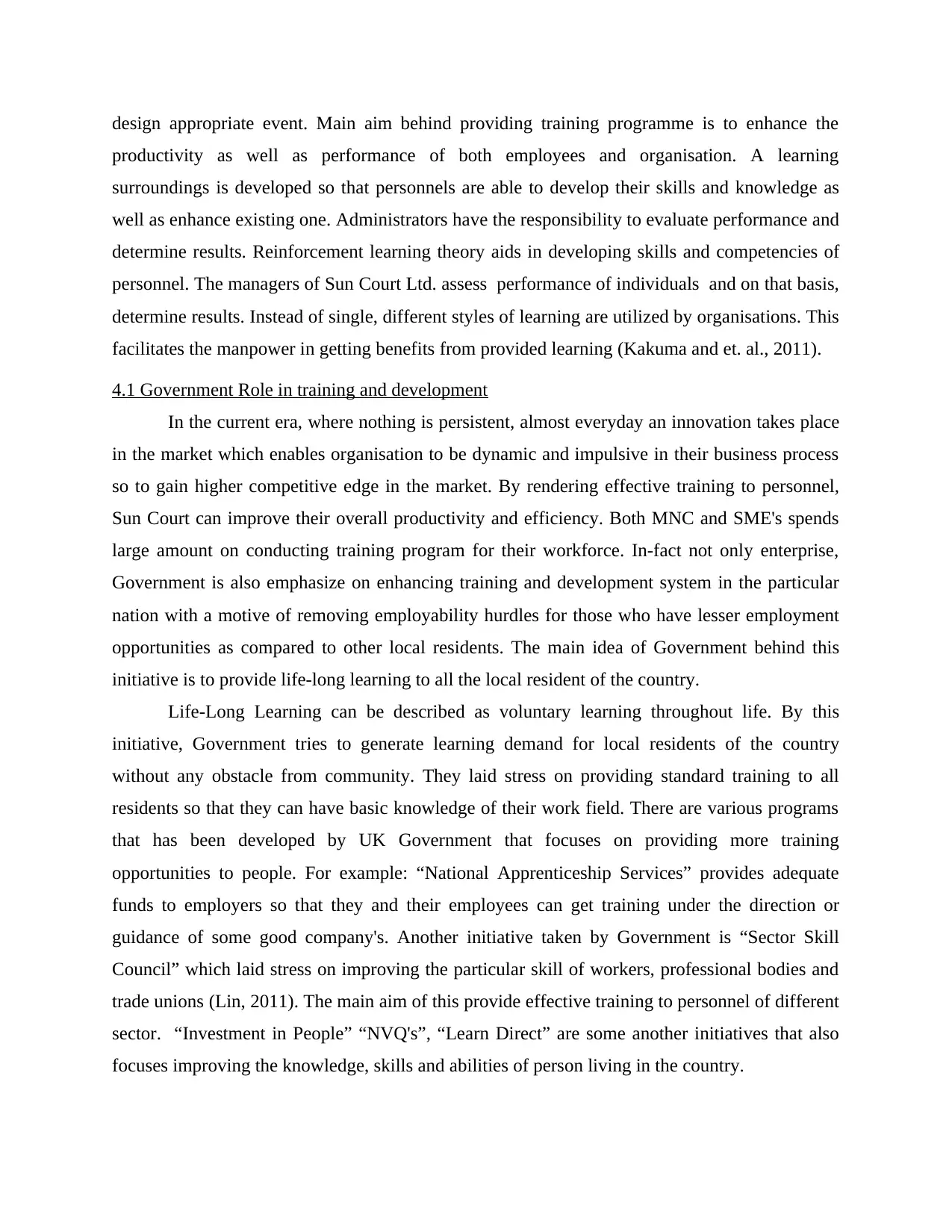
design appropriate event. Main aim behind providing training programme is to enhance the
productivity as well as performance of both employees and organisation. A learning
surroundings is developed so that personnels are able to develop their skills and knowledge as
well as enhance existing one. Administrators have the responsibility to evaluate performance and
determine results. Reinforcement learning theory aids in developing skills and competencies of
personnel. The managers of Sun Court Ltd. assess performance of individuals and on that basis,
determine results. Instead of single, different styles of learning are utilized by organisations. This
facilitates the manpower in getting benefits from provided learning (Kakuma and et. al., 2011).
4.1 Government Role in training and development
In the current era, where nothing is persistent, almost everyday an innovation takes place
in the market which enables organisation to be dynamic and impulsive in their business process
so to gain higher competitive edge in the market. By rendering effective training to personnel,
Sun Court can improve their overall productivity and efficiency. Both MNC and SME's spends
large amount on conducting training program for their workforce. In-fact not only enterprise,
Government is also emphasize on enhancing training and development system in the particular
nation with a motive of removing employability hurdles for those who have lesser employment
opportunities as compared to other local residents. The main idea of Government behind this
initiative is to provide life-long learning to all the local resident of the country.
Life-Long Learning can be described as voluntary learning throughout life. By this
initiative, Government tries to generate learning demand for local residents of the country
without any obstacle from community. They laid stress on providing standard training to all
residents so that they can have basic knowledge of their work field. There are various programs
that has been developed by UK Government that focuses on providing more training
opportunities to people. For example: “National Apprenticeship Services” provides adequate
funds to employers so that they and their employees can get training under the direction or
guidance of some good company's. Another initiative taken by Government is “Sector Skill
Council” which laid stress on improving the particular skill of workers, professional bodies and
trade unions (Lin, 2011). The main aim of this provide effective training to personnel of different
sector. “Investment in People” “NVQ's”, “Learn Direct” are some another initiatives that also
focuses improving the knowledge, skills and abilities of person living in the country.
productivity as well as performance of both employees and organisation. A learning
surroundings is developed so that personnels are able to develop their skills and knowledge as
well as enhance existing one. Administrators have the responsibility to evaluate performance and
determine results. Reinforcement learning theory aids in developing skills and competencies of
personnel. The managers of Sun Court Ltd. assess performance of individuals and on that basis,
determine results. Instead of single, different styles of learning are utilized by organisations. This
facilitates the manpower in getting benefits from provided learning (Kakuma and et. al., 2011).
4.1 Government Role in training and development
In the current era, where nothing is persistent, almost everyday an innovation takes place
in the market which enables organisation to be dynamic and impulsive in their business process
so to gain higher competitive edge in the market. By rendering effective training to personnel,
Sun Court can improve their overall productivity and efficiency. Both MNC and SME's spends
large amount on conducting training program for their workforce. In-fact not only enterprise,
Government is also emphasize on enhancing training and development system in the particular
nation with a motive of removing employability hurdles for those who have lesser employment
opportunities as compared to other local residents. The main idea of Government behind this
initiative is to provide life-long learning to all the local resident of the country.
Life-Long Learning can be described as voluntary learning throughout life. By this
initiative, Government tries to generate learning demand for local residents of the country
without any obstacle from community. They laid stress on providing standard training to all
residents so that they can have basic knowledge of their work field. There are various programs
that has been developed by UK Government that focuses on providing more training
opportunities to people. For example: “National Apprenticeship Services” provides adequate
funds to employers so that they and their employees can get training under the direction or
guidance of some good company's. Another initiative taken by Government is “Sector Skill
Council” which laid stress on improving the particular skill of workers, professional bodies and
trade unions (Lin, 2011). The main aim of this provide effective training to personnel of different
sector. “Investment in People” “NVQ's”, “Learn Direct” are some another initiatives that also
focuses improving the knowledge, skills and abilities of person living in the country.
⊘ This is a preview!⊘
Do you want full access?
Subscribe today to unlock all pages.

Trusted by 1+ million students worldwide
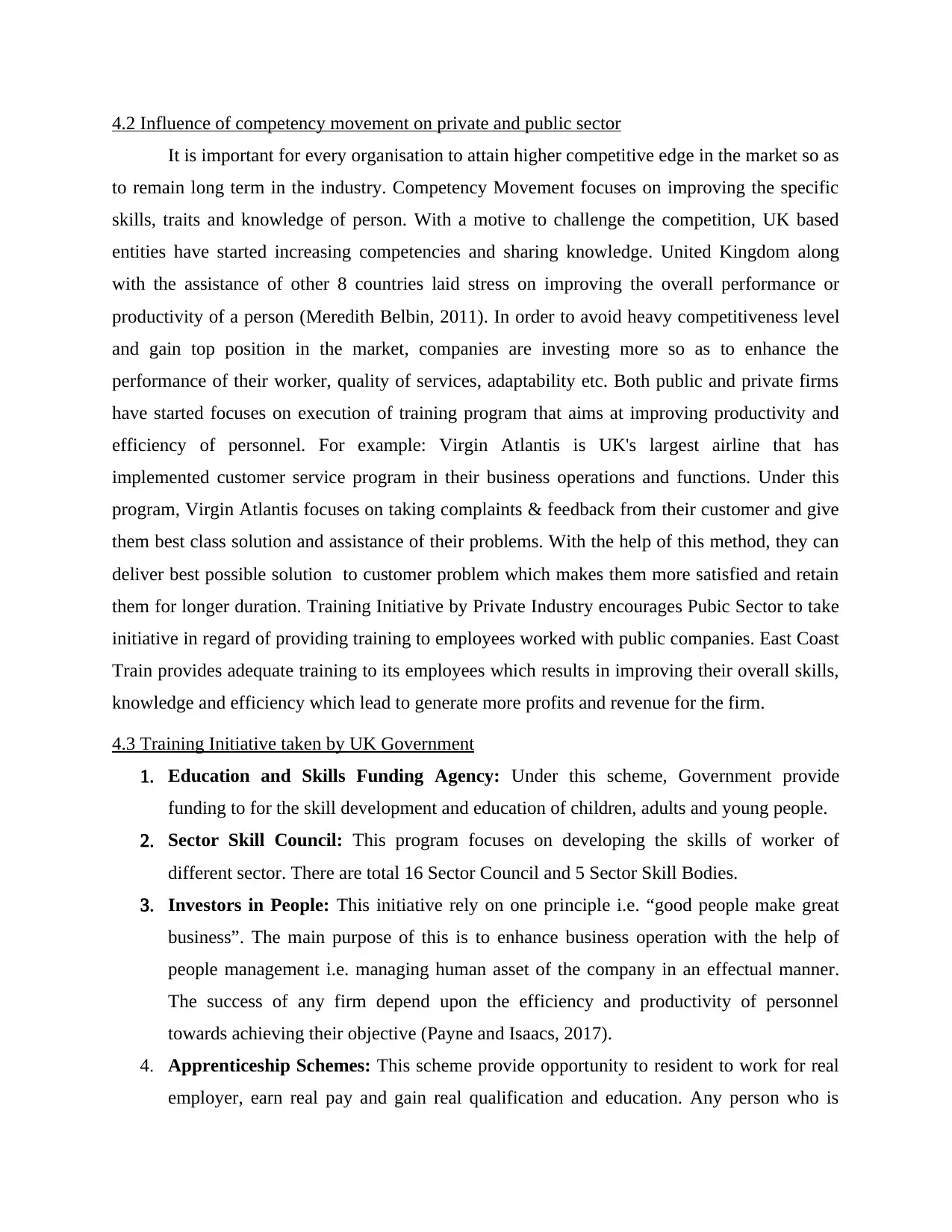
4.2 Influence of competency movement on private and public sector
It is important for every organisation to attain higher competitive edge in the market so as
to remain long term in the industry. Competency Movement focuses on improving the specific
skills, traits and knowledge of person. With a motive to challenge the competition, UK based
entities have started increasing competencies and sharing knowledge. United Kingdom along
with the assistance of other 8 countries laid stress on improving the overall performance or
productivity of a person (Meredith Belbin, 2011). In order to avoid heavy competitiveness level
and gain top position in the market, companies are investing more so as to enhance the
performance of their worker, quality of services, adaptability etc. Both public and private firms
have started focuses on execution of training program that aims at improving productivity and
efficiency of personnel. For example: Virgin Atlantis is UK's largest airline that has
implemented customer service program in their business operations and functions. Under this
program, Virgin Atlantis focuses on taking complaints & feedback from their customer and give
them best class solution and assistance of their problems. With the help of this method, they can
deliver best possible solution to customer problem which makes them more satisfied and retain
them for longer duration. Training Initiative by Private Industry encourages Pubic Sector to take
initiative in regard of providing training to employees worked with public companies. East Coast
Train provides adequate training to its employees which results in improving their overall skills,
knowledge and efficiency which lead to generate more profits and revenue for the firm.
4.3 Training Initiative taken by UK Government
1. Education and Skills Funding Agency: Under this scheme, Government provide
funding to for the skill development and education of children, adults and young people.
2. Sector Skill Council: This program focuses on developing the skills of worker of
different sector. There are total 16 Sector Council and 5 Sector Skill Bodies.
3. Investors in People: This initiative rely on one principle i.e. “good people make great
business”. The main purpose of this is to enhance business operation with the help of
people management i.e. managing human asset of the company in an effectual manner.
The success of any firm depend upon the efficiency and productivity of personnel
towards achieving their objective (Payne and Isaacs, 2017).
4. Apprenticeship Schemes: This scheme provide opportunity to resident to work for real
employer, earn real pay and gain real qualification and education. Any person who is
It is important for every organisation to attain higher competitive edge in the market so as
to remain long term in the industry. Competency Movement focuses on improving the specific
skills, traits and knowledge of person. With a motive to challenge the competition, UK based
entities have started increasing competencies and sharing knowledge. United Kingdom along
with the assistance of other 8 countries laid stress on improving the overall performance or
productivity of a person (Meredith Belbin, 2011). In order to avoid heavy competitiveness level
and gain top position in the market, companies are investing more so as to enhance the
performance of their worker, quality of services, adaptability etc. Both public and private firms
have started focuses on execution of training program that aims at improving productivity and
efficiency of personnel. For example: Virgin Atlantis is UK's largest airline that has
implemented customer service program in their business operations and functions. Under this
program, Virgin Atlantis focuses on taking complaints & feedback from their customer and give
them best class solution and assistance of their problems. With the help of this method, they can
deliver best possible solution to customer problem which makes them more satisfied and retain
them for longer duration. Training Initiative by Private Industry encourages Pubic Sector to take
initiative in regard of providing training to employees worked with public companies. East Coast
Train provides adequate training to its employees which results in improving their overall skills,
knowledge and efficiency which lead to generate more profits and revenue for the firm.
4.3 Training Initiative taken by UK Government
1. Education and Skills Funding Agency: Under this scheme, Government provide
funding to for the skill development and education of children, adults and young people.
2. Sector Skill Council: This program focuses on developing the skills of worker of
different sector. There are total 16 Sector Council and 5 Sector Skill Bodies.
3. Investors in People: This initiative rely on one principle i.e. “good people make great
business”. The main purpose of this is to enhance business operation with the help of
people management i.e. managing human asset of the company in an effectual manner.
The success of any firm depend upon the efficiency and productivity of personnel
towards achieving their objective (Payne and Isaacs, 2017).
4. Apprenticeship Schemes: This scheme provide opportunity to resident to work for real
employer, earn real pay and gain real qualification and education. Any person who is
Paraphrase This Document
Need a fresh take? Get an instant paraphrase of this document with our AI Paraphraser
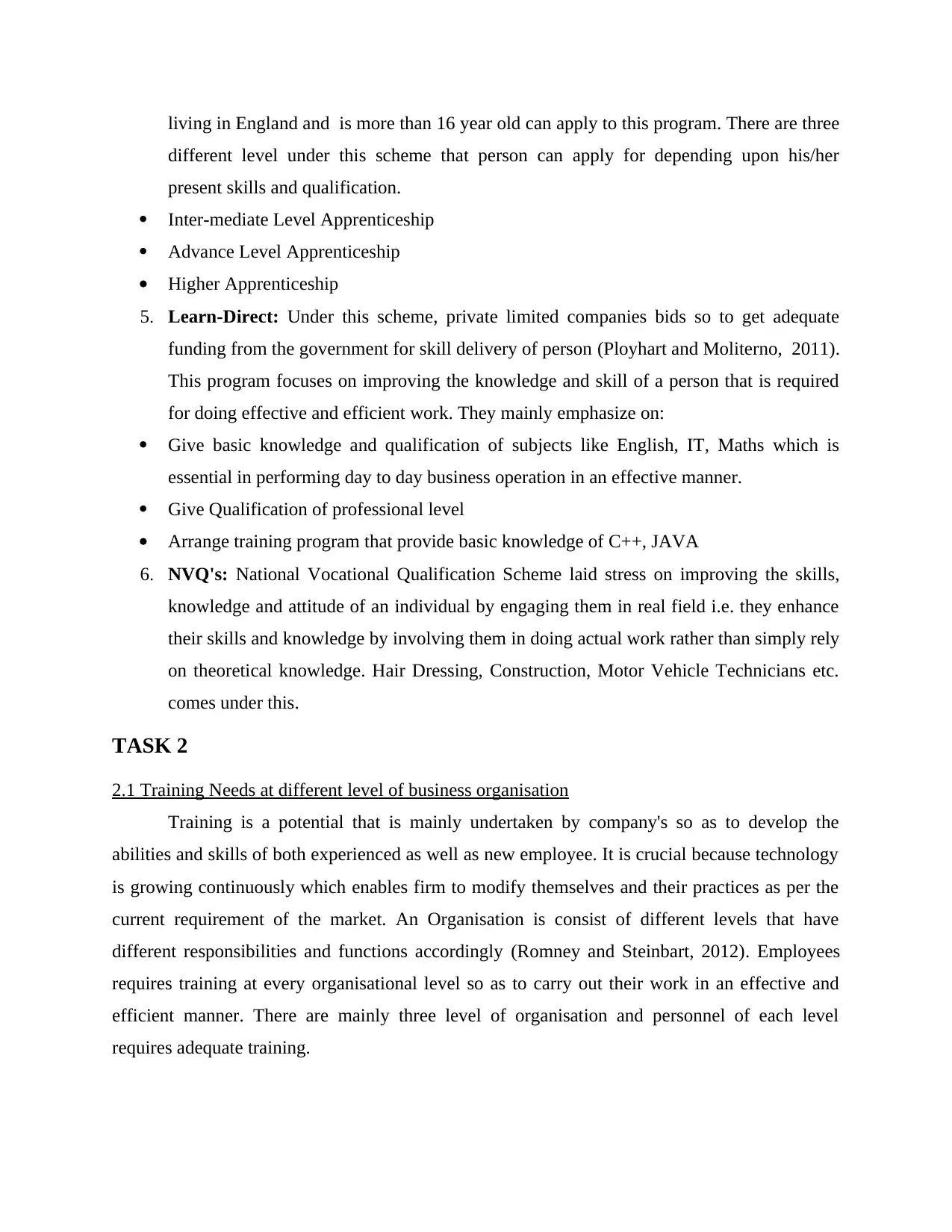
living in England and is more than 16 year old can apply to this program. There are three
different level under this scheme that person can apply for depending upon his/her
present skills and qualification.
Inter-mediate Level Apprenticeship
Advance Level Apprenticeship
Higher Apprenticeship
5. Learn-Direct: Under this scheme, private limited companies bids so to get adequate
funding from the government for skill delivery of person (Ployhart and Moliterno, 2011).
This program focuses on improving the knowledge and skill of a person that is required
for doing effective and efficient work. They mainly emphasize on:
Give basic knowledge and qualification of subjects like English, IT, Maths which is
essential in performing day to day business operation in an effective manner.
Give Qualification of professional level
Arrange training program that provide basic knowledge of C++, JAVA
6. NVQ's: National Vocational Qualification Scheme laid stress on improving the skills,
knowledge and attitude of an individual by engaging them in real field i.e. they enhance
their skills and knowledge by involving them in doing actual work rather than simply rely
on theoretical knowledge. Hair Dressing, Construction, Motor Vehicle Technicians etc.
comes under this.
TASK 2
2.1 Training Needs at different level of business organisation
Training is a potential that is mainly undertaken by company's so as to develop the
abilities and skills of both experienced as well as new employee. It is crucial because technology
is growing continuously which enables firm to modify themselves and their practices as per the
current requirement of the market. An Organisation is consist of different levels that have
different responsibilities and functions accordingly (Romney and Steinbart, 2012). Employees
requires training at every organisational level so as to carry out their work in an effective and
efficient manner. There are mainly three level of organisation and personnel of each level
requires adequate training.
different level under this scheme that person can apply for depending upon his/her
present skills and qualification.
Inter-mediate Level Apprenticeship
Advance Level Apprenticeship
Higher Apprenticeship
5. Learn-Direct: Under this scheme, private limited companies bids so to get adequate
funding from the government for skill delivery of person (Ployhart and Moliterno, 2011).
This program focuses on improving the knowledge and skill of a person that is required
for doing effective and efficient work. They mainly emphasize on:
Give basic knowledge and qualification of subjects like English, IT, Maths which is
essential in performing day to day business operation in an effective manner.
Give Qualification of professional level
Arrange training program that provide basic knowledge of C++, JAVA
6. NVQ's: National Vocational Qualification Scheme laid stress on improving the skills,
knowledge and attitude of an individual by engaging them in real field i.e. they enhance
their skills and knowledge by involving them in doing actual work rather than simply rely
on theoretical knowledge. Hair Dressing, Construction, Motor Vehicle Technicians etc.
comes under this.
TASK 2
2.1 Training Needs at different level of business organisation
Training is a potential that is mainly undertaken by company's so as to develop the
abilities and skills of both experienced as well as new employee. It is crucial because technology
is growing continuously which enables firm to modify themselves and their practices as per the
current requirement of the market. An Organisation is consist of different levels that have
different responsibilities and functions accordingly (Romney and Steinbart, 2012). Employees
requires training at every organisational level so as to carry out their work in an effective and
efficient manner. There are mainly three level of organisation and personnel of each level
requires adequate training.
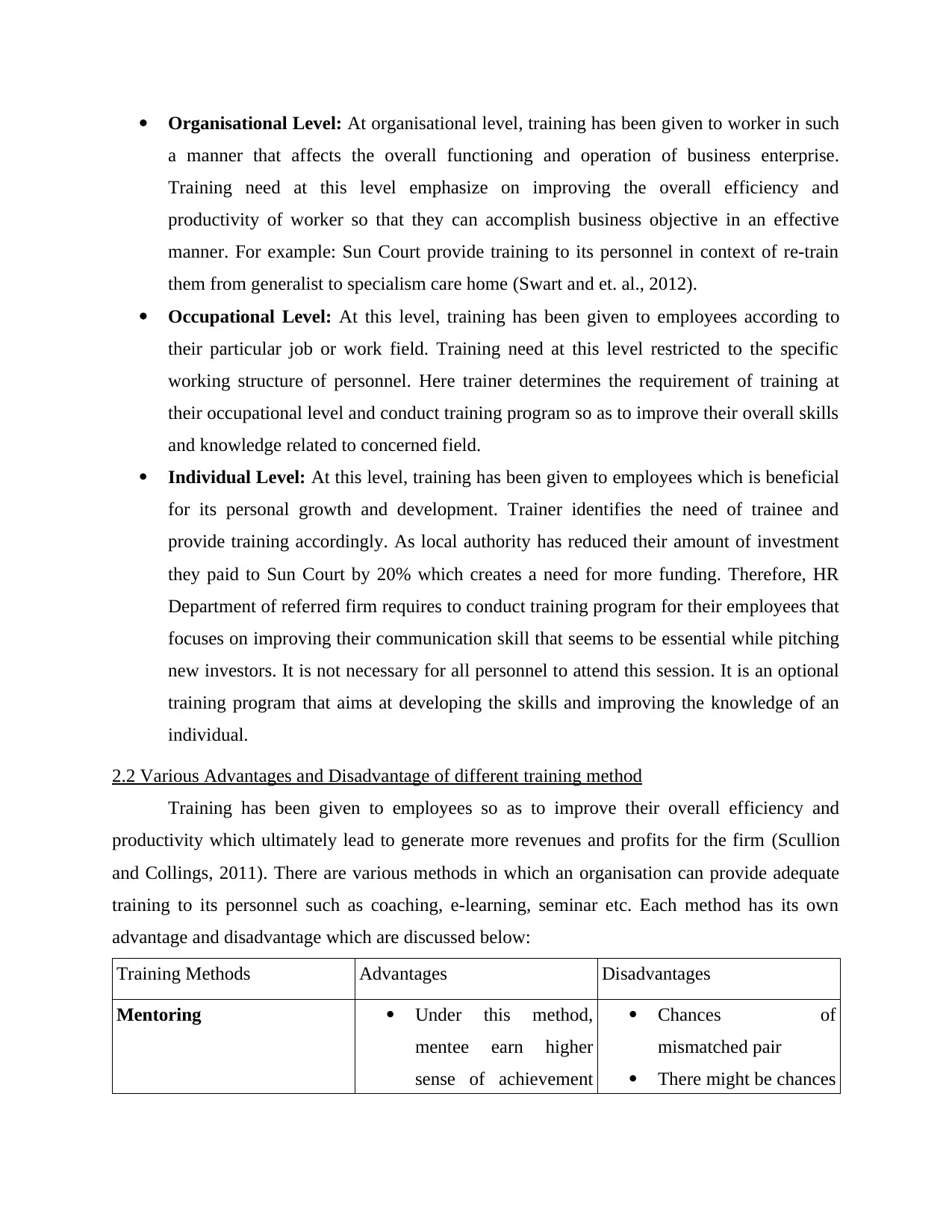
Organisational Level: At organisational level, training has been given to worker in such
a manner that affects the overall functioning and operation of business enterprise.
Training need at this level emphasize on improving the overall efficiency and
productivity of worker so that they can accomplish business objective in an effective
manner. For example: Sun Court provide training to its personnel in context of re-train
them from generalist to specialism care home (Swart and et. al., 2012).
Occupational Level: At this level, training has been given to employees according to
their particular job or work field. Training need at this level restricted to the specific
working structure of personnel. Here trainer determines the requirement of training at
their occupational level and conduct training program so as to improve their overall skills
and knowledge related to concerned field.
Individual Level: At this level, training has been given to employees which is beneficial
for its personal growth and development. Trainer identifies the need of trainee and
provide training accordingly. As local authority has reduced their amount of investment
they paid to Sun Court by 20% which creates a need for more funding. Therefore, HR
Department of referred firm requires to conduct training program for their employees that
focuses on improving their communication skill that seems to be essential while pitching
new investors. It is not necessary for all personnel to attend this session. It is an optional
training program that aims at developing the skills and improving the knowledge of an
individual.
2.2 Various Advantages and Disadvantage of different training method
Training has been given to employees so as to improve their overall efficiency and
productivity which ultimately lead to generate more revenues and profits for the firm (Scullion
and Collings, 2011). There are various methods in which an organisation can provide adequate
training to its personnel such as coaching, e-learning, seminar etc. Each method has its own
advantage and disadvantage which are discussed below:
Training Methods Advantages Disadvantages
Mentoring Under this method,
mentee earn higher
sense of achievement
Chances of
mismatched pair
There might be chances
a manner that affects the overall functioning and operation of business enterprise.
Training need at this level emphasize on improving the overall efficiency and
productivity of worker so that they can accomplish business objective in an effective
manner. For example: Sun Court provide training to its personnel in context of re-train
them from generalist to specialism care home (Swart and et. al., 2012).
Occupational Level: At this level, training has been given to employees according to
their particular job or work field. Training need at this level restricted to the specific
working structure of personnel. Here trainer determines the requirement of training at
their occupational level and conduct training program so as to improve their overall skills
and knowledge related to concerned field.
Individual Level: At this level, training has been given to employees which is beneficial
for its personal growth and development. Trainer identifies the need of trainee and
provide training accordingly. As local authority has reduced their amount of investment
they paid to Sun Court by 20% which creates a need for more funding. Therefore, HR
Department of referred firm requires to conduct training program for their employees that
focuses on improving their communication skill that seems to be essential while pitching
new investors. It is not necessary for all personnel to attend this session. It is an optional
training program that aims at developing the skills and improving the knowledge of an
individual.
2.2 Various Advantages and Disadvantage of different training method
Training has been given to employees so as to improve their overall efficiency and
productivity which ultimately lead to generate more revenues and profits for the firm (Scullion
and Collings, 2011). There are various methods in which an organisation can provide adequate
training to its personnel such as coaching, e-learning, seminar etc. Each method has its own
advantage and disadvantage which are discussed below:
Training Methods Advantages Disadvantages
Mentoring Under this method,
mentee earn higher
sense of achievement
Chances of
mismatched pair
There might be chances
⊘ This is a preview!⊘
Do you want full access?
Subscribe today to unlock all pages.

Trusted by 1+ million students worldwide
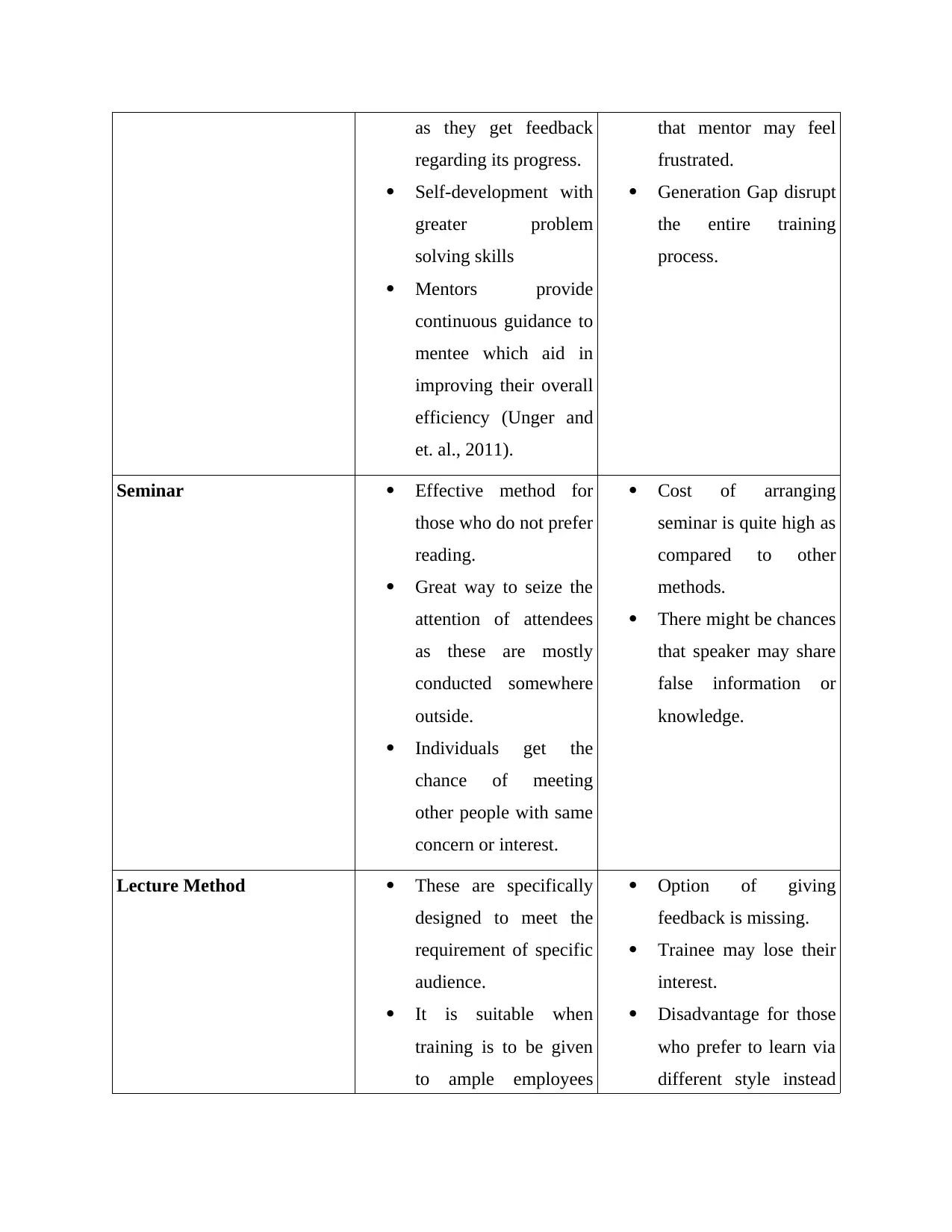
as they get feedback
regarding its progress.
Self-development with
greater problem
solving skills
Mentors provide
continuous guidance to
mentee which aid in
improving their overall
efficiency (Unger and
et. al., 2011).
that mentor may feel
frustrated.
Generation Gap disrupt
the entire training
process.
Seminar Effective method for
those who do not prefer
reading.
Great way to seize the
attention of attendees
as these are mostly
conducted somewhere
outside.
Individuals get the
chance of meeting
other people with same
concern or interest.
Cost of arranging
seminar is quite high as
compared to other
methods.
There might be chances
that speaker may share
false information or
knowledge.
Lecture Method These are specifically
designed to meet the
requirement of specific
audience.
It is suitable when
training is to be given
to ample employees
Option of giving
feedback is missing.
Trainee may lose their
interest.
Disadvantage for those
who prefer to learn via
different style instead
regarding its progress.
Self-development with
greater problem
solving skills
Mentors provide
continuous guidance to
mentee which aid in
improving their overall
efficiency (Unger and
et. al., 2011).
that mentor may feel
frustrated.
Generation Gap disrupt
the entire training
process.
Seminar Effective method for
those who do not prefer
reading.
Great way to seize the
attention of attendees
as these are mostly
conducted somewhere
outside.
Individuals get the
chance of meeting
other people with same
concern or interest.
Cost of arranging
seminar is quite high as
compared to other
methods.
There might be chances
that speaker may share
false information or
knowledge.
Lecture Method These are specifically
designed to meet the
requirement of specific
audience.
It is suitable when
training is to be given
to ample employees
Option of giving
feedback is missing.
Trainee may lose their
interest.
Disadvantage for those
who prefer to learn via
different style instead
Paraphrase This Document
Need a fresh take? Get an instant paraphrase of this document with our AI Paraphraser
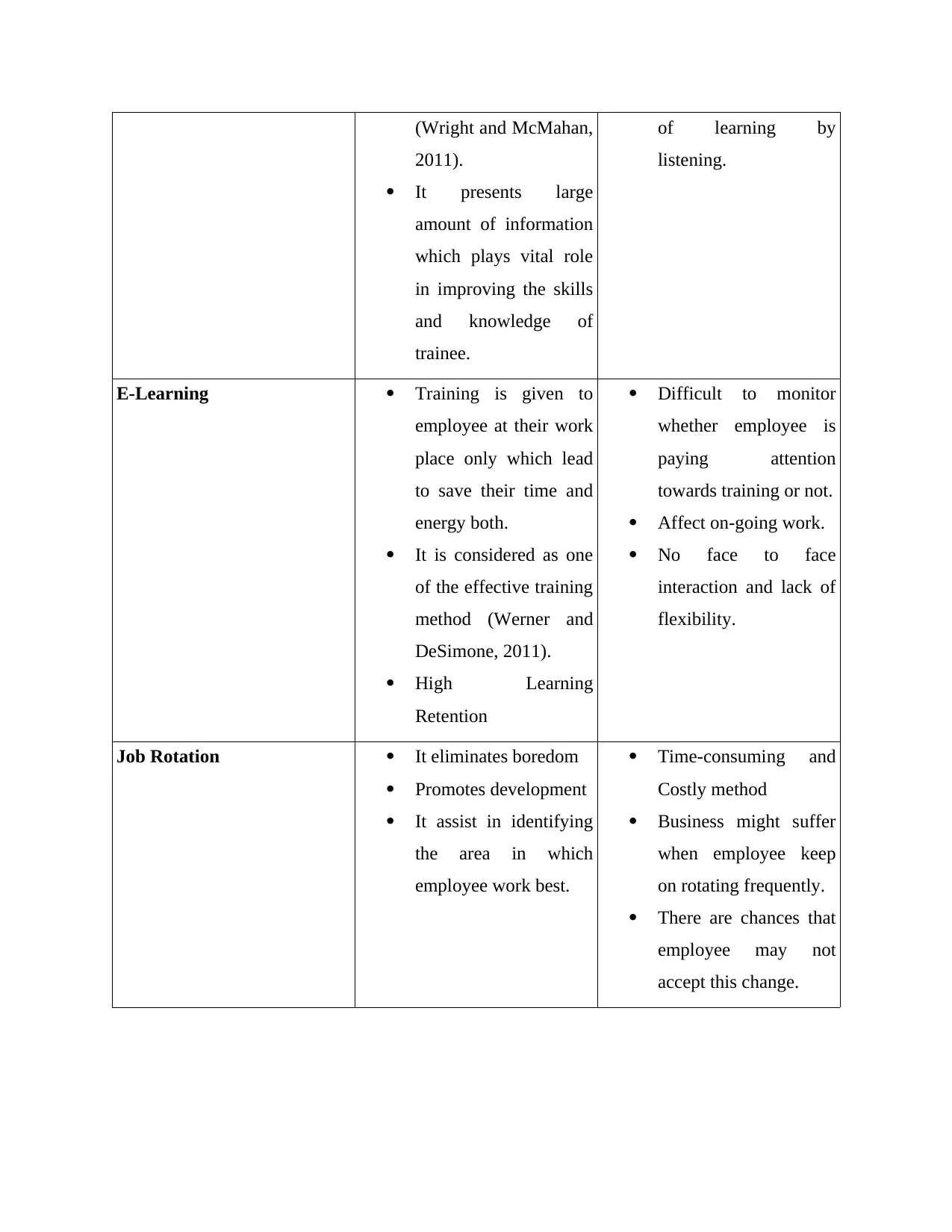
(Wright and McMahan,
2011).
It presents large
amount of information
which plays vital role
in improving the skills
and knowledge of
trainee.
of learning by
listening.
E-Learning Training is given to
employee at their work
place only which lead
to save their time and
energy both.
It is considered as one
of the effective training
method (Werner and
DeSimone, 2011).
High Learning
Retention
Difficult to monitor
whether employee is
paying attention
towards training or not.
Affect on-going work.
No face to face
interaction and lack of
flexibility.
Job Rotation It eliminates boredom
Promotes development
It assist in identifying
the area in which
employee work best.
Time-consuming and
Costly method
Business might suffer
when employee keep
on rotating frequently.
There are chances that
employee may not
accept this change.
2011).
It presents large
amount of information
which plays vital role
in improving the skills
and knowledge of
trainee.
of learning by
listening.
E-Learning Training is given to
employee at their work
place only which lead
to save their time and
energy both.
It is considered as one
of the effective training
method (Werner and
DeSimone, 2011).
High Learning
Retention
Difficult to monitor
whether employee is
paying attention
towards training or not.
Affect on-going work.
No face to face
interaction and lack of
flexibility.
Job Rotation It eliminates boredom
Promotes development
It assist in identifying
the area in which
employee work best.
Time-consuming and
Costly method
Business might suffer
when employee keep
on rotating frequently.
There are chances that
employee may not
accept this change.
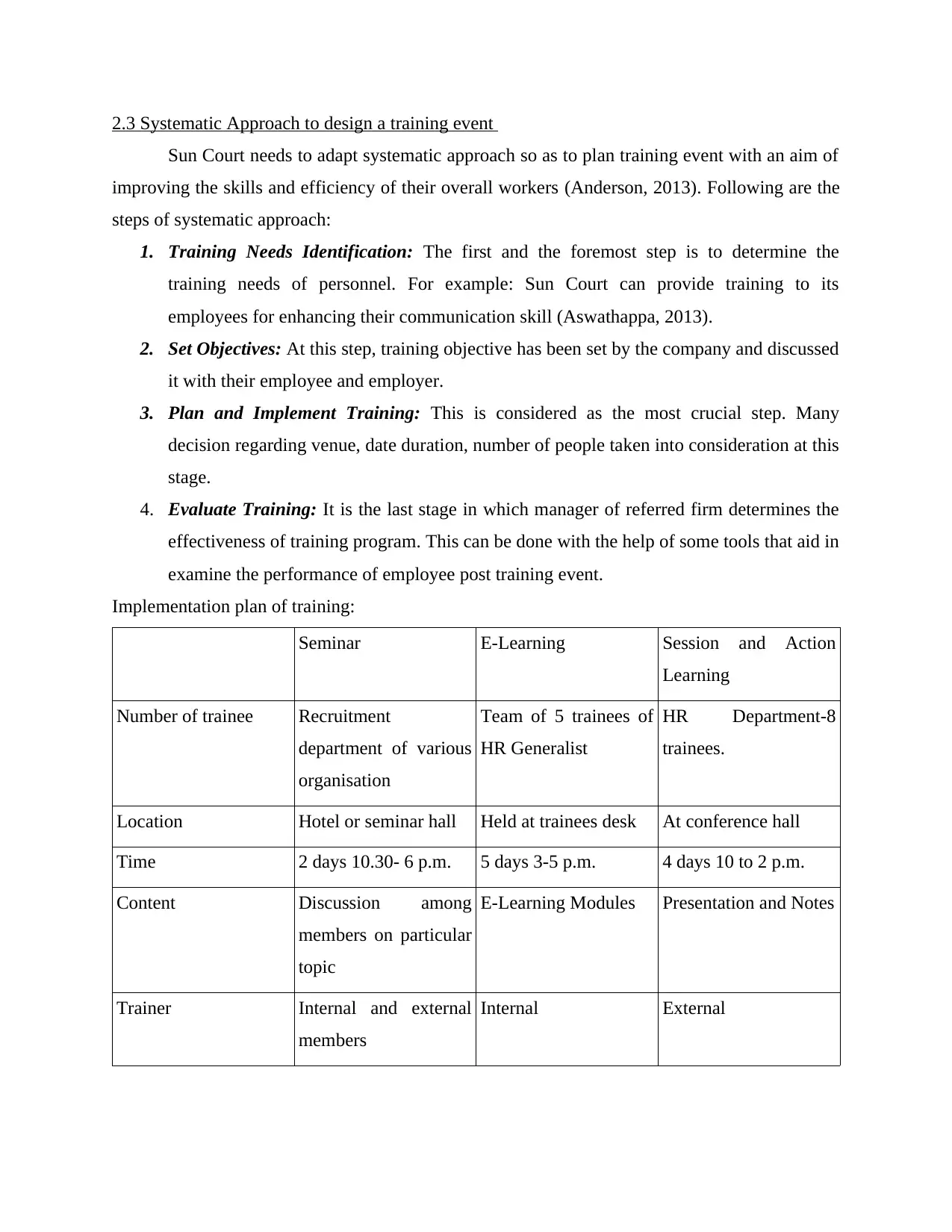
2.3 Systematic Approach to design a training event
Sun Court needs to adapt systematic approach so as to plan training event with an aim of
improving the skills and efficiency of their overall workers (Anderson, 2013). Following are the
steps of systematic approach:
1. Training Needs Identification: The first and the foremost step is to determine the
training needs of personnel. For example: Sun Court can provide training to its
employees for enhancing their communication skill (Aswathappa, 2013).
2. Set Objectives: At this step, training objective has been set by the company and discussed
it with their employee and employer.
3. Plan and Implement Training: This is considered as the most crucial step. Many
decision regarding venue, date duration, number of people taken into consideration at this
stage.
4. Evaluate Training: It is the last stage in which manager of referred firm determines the
effectiveness of training program. This can be done with the help of some tools that aid in
examine the performance of employee post training event.
Implementation plan of training:
Seminar E-Learning Session and Action
Learning
Number of trainee Recruitment
department of various
organisation
Team of 5 trainees of
HR Generalist
HR Department-8
trainees.
Location Hotel or seminar hall Held at trainees desk At conference hall
Time 2 days 10.30- 6 p.m. 5 days 3-5 p.m. 4 days 10 to 2 p.m.
Content Discussion among
members on particular
topic
E-Learning Modules Presentation and Notes
Trainer Internal and external
members
Internal External
Sun Court needs to adapt systematic approach so as to plan training event with an aim of
improving the skills and efficiency of their overall workers (Anderson, 2013). Following are the
steps of systematic approach:
1. Training Needs Identification: The first and the foremost step is to determine the
training needs of personnel. For example: Sun Court can provide training to its
employees for enhancing their communication skill (Aswathappa, 2013).
2. Set Objectives: At this step, training objective has been set by the company and discussed
it with their employee and employer.
3. Plan and Implement Training: This is considered as the most crucial step. Many
decision regarding venue, date duration, number of people taken into consideration at this
stage.
4. Evaluate Training: It is the last stage in which manager of referred firm determines the
effectiveness of training program. This can be done with the help of some tools that aid in
examine the performance of employee post training event.
Implementation plan of training:
Seminar E-Learning Session and Action
Learning
Number of trainee Recruitment
department of various
organisation
Team of 5 trainees of
HR Generalist
HR Department-8
trainees.
Location Hotel or seminar hall Held at trainees desk At conference hall
Time 2 days 10.30- 6 p.m. 5 days 3-5 p.m. 4 days 10 to 2 p.m.
Content Discussion among
members on particular
topic
E-Learning Modules Presentation and Notes
Trainer Internal and external
members
Internal External
⊘ This is a preview!⊘
Do you want full access?
Subscribe today to unlock all pages.

Trusted by 1+ million students worldwide
1 out of 16
Related Documents
Your All-in-One AI-Powered Toolkit for Academic Success.
+13062052269
info@desklib.com
Available 24*7 on WhatsApp / Email
![[object Object]](/_next/static/media/star-bottom.7253800d.svg)
Unlock your academic potential
Copyright © 2020–2025 A2Z Services. All Rights Reserved. Developed and managed by ZUCOL.





